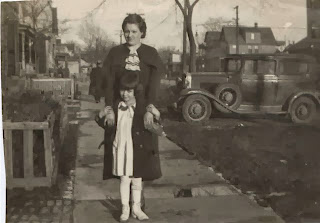 |
| This is my grandma and my aunt. As you can see, my aunt has a leg brace from polio. The question is, how much of her true life story do I use in my polio novel? |
One of the main reasons people seem to begin writing a children’s book is that they have a personal story they want to tell. It’s often a childhood memory. What can be difficult is separating fact from fiction. Maybe you have this wonderfully vivid memory from your childhood. You feel that everyone will enjoy it, too. There are a couple of problems I have noticed as I've read other people's work.
1—
Number of Characters: Many times the real incident had quite a few friends or siblings or cousins or dogs. Often, the heart of the picture book story doesn’t need so many. Your seven-year-old reader doesn’t need Uncle Larry and Milky the Cat in your story. Maybe the character said one funny line you just can't bear to take out. But was that one line something someone else can say in the story? Try melting two characters into one.
2—
Setting Details: I know I pride myself on having a good memory. When writing a story based on a real-life experience, you often want to include everything you remember, down to the color of the bathroom shower curtain. Again, is this detail something crucial to the story? Often the writer tries to complicate the layout of the house, yard, etc. because they want the story to take place in the house they grew up in. This can add a lot of superfluous explanation. Change your setting to make it detailed but simple to picture.
3—
Plot: The plot can be the biggest obstacle when using a memory to create a story. Sometimes your memory is just a moment in time—no real conflict happened. If you’re really serious about making your book stand out to editors, you need something to happen in your book--a conflict. This can be hard—you’ve written this sweet story about your real cousin, Melba, and her adorable kitten, Jingles. You just can’t make something bad happen them.
I challenge you to find a book (in the same genre you’re writing for) where nothing happens. It’s rare. There are concept books (books on shapes, words, numbers, etc.) as well as night time books where you could argue that nothing happens. But, chances are you pictured the book you are working on as a picture book or a novel. Physically pull from the shelves of your Barnes & Noble, library or kids’ bookshelf books with the look and feel of your potential book. Dissect those books’ plots. Does something happen?
4—
Character Names: Do you come from a family of all p-names? Peter, Patty, Pamela, Perry, and Patrick. This might work for some stories, but reading off all these names each time you’re referring to the characters in a book may be distracting to the reader. Often writers try to avoid names that start with the same letter or sound too similar—it can get confusing to the reader (wait, was Brandon the murderer or was Brendon?). You may also have to change a character's name to fit the mood of the book. If it's a serious book, you don't want a somewhat silly-sounding name. If it's a silly book, make it sillier with a fun name.
What it boils down to is keeping your reader in mind. Are the details you’re including necessary and interesting? Are they universal enough that they automatically make sense to the reader? If not, figure out how to cut or change them. You want to make your memory as special to the reader as it was to you.




 If you’ve never used format painter, you will be so happy to finally know
what that big paintbrush icon can do.
If you’ve never used format painter, you will be so happy to finally know
what that big paintbrush icon can do. 
.jpg) In the past, I kept some and recycled the rest. But I’m not big on instantly recycling everything—recycling should really be used as a last resort. Although I’ve thought about sending an e-card rather than a printed card every year, I’m not ready for that. Obviously, my friends aren’t ready to stop sending printed cards either. So what to do with all of these lovely cards…
In the past, I kept some and recycled the rest. But I’m not big on instantly recycling everything—recycling should really be used as a last resort. Although I’ve thought about sending an e-card rather than a printed card every year, I’m not ready for that. Obviously, my friends aren’t ready to stop sending printed cards either. So what to do with all of these lovely cards…